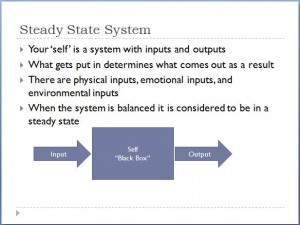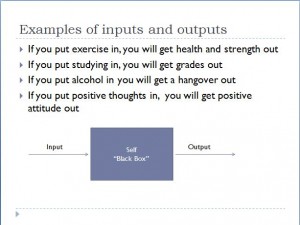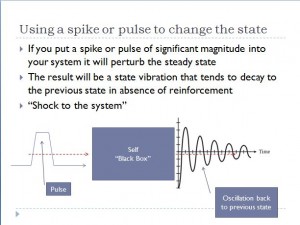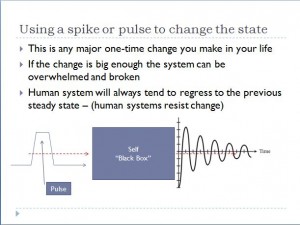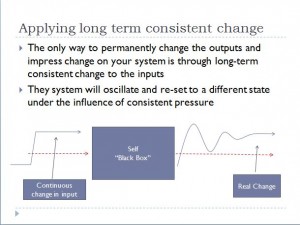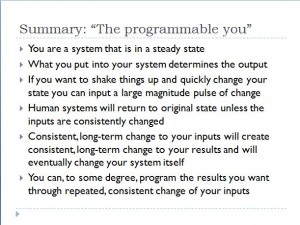The system theory of life balance.
 In our ongoing series on life balance we have so far discussed two topics. The first was a discussion on how to visualize and balance the different areas of your life. The second was an exercise in defining ‘self’ or what makes you as an individual being tick. What I’d like to share with you today is another useful model that allows you to influence and change the outputs of your life.
In our ongoing series on life balance we have so far discussed two topics. The first was a discussion on how to visualize and balance the different areas of your life. The second was an exercise in defining ‘self’ or what makes you as an individual being tick. What I’d like to share with you today is another useful model that allows you to influence and change the outputs of your life.
When I first graduated from school, I had degrees in Business and English. My first job was in high-tech at a computer manufacturing company.
In this company I was surrounded by engineers. I was impressed by how these engineers, by dint of their technical knowledge, were confident that they knew everything. They had discrete, certain answers for every question.
Having discrete and certain answers to everything seemed like an appealing thing, so I went back to school at night and got an engineering degree. It turns out that these guys, and yes they were all guys, had no more answers than anyone else. In a sense they had answers to smaller questions about the workings of the physical world.
I did learn some things. I did acquire some useful proofs and constructs that I could apply to these larger questions. (As a side note it’s a shame that we have isolated math and physics and logic from the metaphysical. Maybe this is a more expedient way to feed technical competence into industry but I think the old Renaissance model of combining the two would produce a far more interesting and thoughtful populace.)
One of the things I picked up was what I’ve come to call “the system theory of self”. At the basic level this uses the constructs of system dynamics to model cause and effect in changing your outcomes. We treat the concept of ‘self improvement’ like any rational engineer would. In this theory you are a discrete system, like a computer, that can be discretely defined, understood, designed, programmed and fixed.
Of course, the fallacy of this theory is that humans are not discrete and rational. They are infinite and irrational. None the less it is an interesting and useful construct that allows us to aggregate and direct our energies and actions. It allows us to approximate a rational framework onto our irrational selves.
Why is this useful? In part one of this series we talked about the crucial end goal of achieving life balance by understanding the interplay of the different areas of your life in the context of finite time. In part two we went through an exercise of defining what your ‘self’ is, of understanding what drives you so that you could better direct that balance in alignment with what is important to you.
In this, the third topic we talk about a framework for change to direct and control the outputs that define the components of your life balance. I know that sounds a bit complex and academic but what we are doing is simply determining the best way to create change to support our life balance goals.
Today we are going to discuss a framework for this change and why it is so hard to create meaningful and sustainable change in our lives.
Let’s begin by drawing a picture of our ‘self’ as a simple system. First draw a box that represents the system of you. We talked last time about how this is a black box and we can only infer what’s inside the box of our ‘self’ by observing patterns in the output.
Next draw an arrow entering the box. This represents all the inputs to your system. Then draw an arrow exiting the box. This represents the outputs or the results.
Your system, your self is unique. It will uniquely react to the inputs you give it. By changing or manipulating the inputs you can manipulate and change the outputs. I have created a simple chart that is part of this post to illustrate this.
In your environment there are an infinite number of inputs. Some of these inputs you control. For example exercise is a physical input to your system and being in shape would be the output or the result.
There are emotional inputs as well. For example, positive thinking and consumption of positive media would be an input and a positive attitude towards life would be the output or the result.
There are relationship inputs. Interacting with compelling and thoughtful people as an input may result in you being a more compelling and thoughtful individual as a result.
As you can see this is a useful construct to explain how your system reacts to and transforms inputs into results. At any given point in time your system is in a stable state with a consistent set of inputs and a consistent set of resulting outputs. This is referred to as a steady state.
The challenge for most people is that they are not entirely happy with their current steady state. They aren’t happy with the results of the current system configuration.
The exciting part of this discussion is that by using this construct you can change the state of your system by manipulating the inputs. Of course, you need to know what outputs you want and that was what the parts one and two were about.
It seems simple, but there is a catch. Human systems don’t like to change and will do their best to go back to the original steady state.
Most people will get to a point where they are fed up with their current state and decide to make a big change. What happens when you insert a big change into a steady state system? You can see in the accompanying illustration that I have depicted this as a big pulse being input into a steady state system.
What is the real life example here? You go on a crash diet. You decide to get off the couch and run 10 miles as your first workout. You walk in the boss’s office and tell her to go to hell. These are major shocks to your system and will indeed change your state…in the short term.
But human systems are natural systems and in absence of continued, consistent pressure on the input side they will oscillate for a bit and then return to the previous steady state.
There is another possible outcome to the shock to the system approach. If the change pulse is big enough it can permanently change the system. Like an overload burning out the circuits you can have a permanently changed state as a result. This can be good like being forced to find a career path that is rewarding because the old one is blown up. Or it can be bad in like instead of being unhappy, you are now unemployed and unhappy.
There are valid reasons to do this but it’s a bit of a high risk scenario. Pulses, or one-time, quick fixes tend to not be effective in the long run because a) human systems resist change and b) human systems always try to regress to the previous steady state in absence of other stimuli.
These types of changes are too hard to sustain and don’t typically lead to long term changes in your outcomes. They might even lead you to conclude that change is impossible to your steady state.
The better way to get a desired output, a desired outcome is to make smaller, logical, sustained changes. If you can sustain the pressure on the inputs in a direction or vector that you want you can create sustainable change in the outcomes of your life.
There is also an illustration for this point in the post. If instead of a one-time pulse you input a consistent level of change you can permanently change not only the outcome but reconfigure the system itself to a new, more desirable, steady state.
The output will still oscillate, but if the change in input is persistent, the output will stabilize at a new level. You have changed your outcomes and you have changed your state.
Why do you care? Why is this helpful? It is helpful because if you know what state of life balance you want to achieve you can create a set of change inputs that are rational, consistent and persistent to move your system in that positive direction over the long term.
Most people live in a steady state created by their environment. They were never taught or told that they could influence this, but you very much can. The information you consume, the people you interact with, every small decision you make is an input that you can control.
Life is chaos, but out of that chaos we can create patterns. We can’t control every infinite point of influence but we can grab hold of the major handles and move the cloud of chaos in a direction that suits our purpose.
As you study the inputs to your system of self you will start to realize that there is a relatively small number of input factors that cause or create your steady state. These few things you can create change momentum in and it will shift your entire system and change your outcomes. Small pushes at these points of leverage will move the ship inexorably towards your desired destination.
I’ll let you go here. I’ll let you chew on, cogitate, these thought exercises. What does your life balance look like? What is your current steady state? What are the characteristics of your ‘self’? What state would you like your life balance to be? To be reflective of, and true to your ‘self’? What changes to your inputs will you make to re-balance your system in that direction?
These are all strategic points that we may come back to as we explore more tactical, supporting topics, but I hope I have given you some foundational thoughts on how to achieve life balance and, let’s face it, sustained happiness in that life balance.
One final thought. As you look at the System Theory of Self consider this. Relationships and your interaction with others is both an input and an output. The way you interact with and influence others is an input to their system of self. This is a powerful responsibility because if we can all change our states it creates a virtuous feedback cycle that will change humanity.

